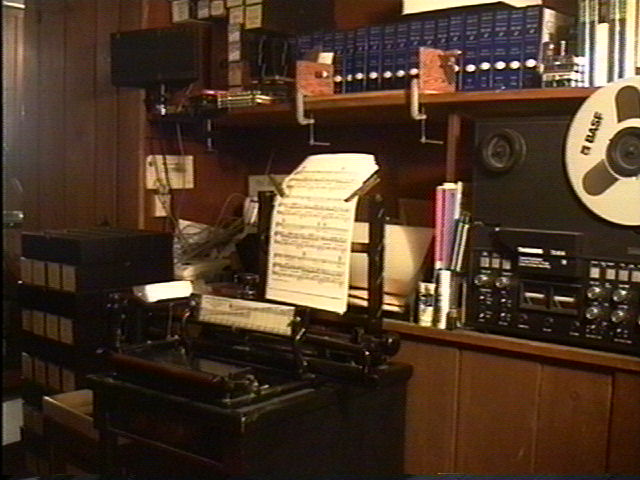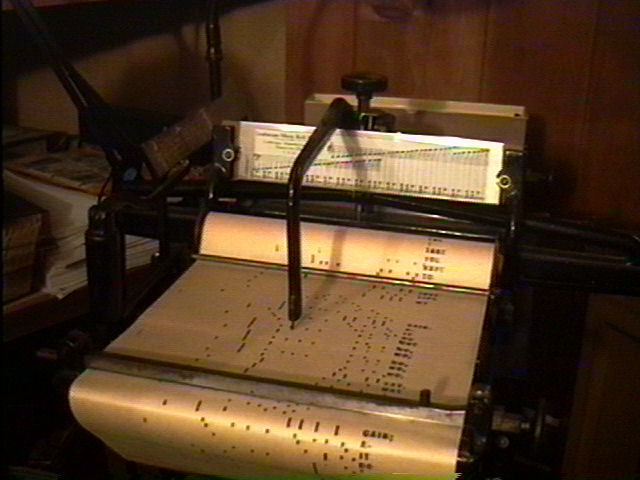

The seeds of the Pianola (or Player-Piano) development began in the player organ field ... primarily reed organs — with pipe organs sharing the same range of 58-Notes [the typical keyboard scale on consoles of that period]. Quasi-standardization of the 58-Note scale was a major leap forward, but it also set the tone for music roll arranging, since the methods of the late 19th Century were strictly SHEET MUSIC TRANSFERS — that is, the layout of rolls based on musical notation standards. This was a benefit for the early player organs (the Aeolian Grand, the Orchestrelle and the Aeolienne [pipe organ]) but soon became a curse, for the pianoforte does NOT take kindly to "connected-note" organ-like performances on its keyboard. Linear transcriptions of sheet music are perfectly acceptable for organ playing, but they are entirely inappropriate for the pianoforte. Blurred and muddy effects are the result of the same arrangement on a piano. They generate no musical excitement and are extremely 'mechanical sounding' in spite of a skilled roll interpreter. Prior to 1900, player organs outnumbered the pianos which were to be played with music rolls, so factories merely churned-out rolls that were graph paper equivalents of printed sheet music. No pianist could play as the score dictated, nor would any keyboard artist ever wish to perform upon a piano in the manner of an organist. Clearly, the "one-size-fits-all" aspect of the Aeolian Grand and other 58-Note rolls limited the development of the Player-Piano as an artistic instrument.
By 1900, the 65-Note scale replaced the earlier one (as the dominant format) ... and this time the rolls were designed for the piano only! The 11¼" roll width became the norm and the Pianola by Aeolian set the standards, both as an external player device and, after 1903, as an inner-player called the Pianola Piano. Unfortunately, most 65-Note rolls continued to be arranged in the same "graph paper" manner, but the music had a greater range on the keyboard while the focus was directed to piano-playing. Meanwhile the player actions were further refined to include divided hammer rails for softening half of the keyboard, "solo" systems were developed (such as the Themodist and its variants) and the Player-Piano in pedal-operated upright and grand piano form began to generate attention in the musical sphere.
Early in the 20th Century the idea of "hand-played" rolls began, a musical impossibility if one realizes that the roll speeds for 65 and 88-Note arrangements were based on player organ standards. In spite of performance compromises and a variety of other variables, rolls began to appear which were ARRANGED FROM paper strips that were marked or perforated during a performance. These rolls are ratty in rhythm, erratic in striking and extremely poor when staccato effects are considered. Beyond being musically unpleasant, the "hand-played" rolls sounded nothing like the artists they represented — who usually recorded the same selections for phonograph records during the same period of time.
The next step was to issue FAKE "hand-played" rolls, i.e. mathematical arrangements issued IN THE NAME of real and pseudonym artists, and this is what one encounters from 1921-on, in most cases. Now, the aim was to produce a roll which sounded rhythmically-correct in spite of the fact that the factory formulae forced the music into perforated performances which sounded NOTHING like the pianists on the roll labels. Composers and pianists such as Lee Sims, George Gershwin, Josef Lhévinne, Vladimir Horowitz, J. P. Johnson, 'Fats' Waller and Sergei Rachmaninoff have all been exploited (for pay) by these arranged rolls. Some commercial arrangements, like the work of Howard Lutter for Welte-Licensee, are still spectacular by today's standards — even if they sound nothing like the pianists stamped on the labels of the 'brown box' rolls from the early 'Twenties until the end in 1931. Most, however, were dreary and predictable ... giving one the sense of 'background music' or that 'droning' performance one associates with Player-Pianos.
The development of music rolls ended with the return to arranging, when the FAKE "hand-played" rolls replaced the irritating and affected ones really created from keyboard performances. (Naturally, the false advertising about 'artists' continued since it had marketing appeal at the time.)
Below are two examples of INTERPRETIVE ARRANGEMENTS being played on The ARTCRAFT Studio's 7' Steinway "AR" Duo-Art 'reproducing' grand piano:


The pictures above are small, but one familiar with music rolls will immediately notice two things in the examples illustrated above. First, the perforations are of variable length: no two being exactly the same in key depression time. Secondly, artificially sustained (or "elongated") notes are not part of these INTERPRETIVE ARRANGEMENTS. The bass octaves in the left picture are "lighter" in striking when compared to those in the right illustration, which feature a a "heavier sounding" attack. Absence of homogeneous note clusters — the sin of commercial rolls — can be seen in these two photographs.
The note-score of the 88-Note arrangement is where the 'action' is for any ARTCRAFT release. Should the selection be perforated additionally for the Duo-Art or Ampico 'reproducing' player, the expression score merely highlights the VIRTUOSO performance attributes which are already inherent in the arrangement. These Duo-Art rolls both show the goal of "single note control" which Mr. Henderson's releases feature ... the expression for the Accompaniment (left margin) and the Solo/Theme notes (right margin) is varied, changing every ¼ to ½ inch. The original 'reproducing' rolls, generally speaking, engaged in "frozen" settings, fixing whole musical passages at one dynamic level in the Accompaniment with 2-4 alternating Theme levels for the accents. After playing a couple of the old expression rolls, a grey "SAMENESS" in the music sets the stage for boredom on the part of the listener.
These pictures don't illustrate the superior sustaining pedal effects of ARTCRAFT rolls, but suffice to say they can be played in the company of an accomplished keyboard pianist. (Excessive sustaining pedal effects are perhaps the worst element of the original Ampico and Duo-Art releases). The modern INTERPRETIVE ARRANGEMENT approaches the pneumatic sustaining pedal as something "slower" and completely different from the pianist's use of the device, and — in doing so — achieves artistic heights in pedal shadings, heretofore unknown in the music roll field.
ARTCRAFT Rolls have shared the concert stage, here and abroad, with some of the finest pianists of our time. As one celebrated Gottschalk interpreter exclaimed during a program, after hearing an INTERPRETIVE ARRANGEMENT based on an analysis of his audio recordings, "That's me! Even the parts I can't play sound like me!"

The key to the artistic sucess of ARTCRAFT Rolls lies in the combination of modern audio with vintage 'Leabarjan'™ perforators. Three 'Leabarjan' machines (2 Model #5 and 1 Model #8-B) are in the Studio, along with a variety of Tandberg and Marantz audio equipment, for the analysis of recorded music. Rolls in-progress can be heard immediately through "instant replay" on an electric "AR" or a pedal "O" Steinway-Aeolian player grand piano, only a few steps away. The use of multiple perforators also allows 'test strips' to be cut and these can be auditioned while the Master Roll remains in another 'Leabarjan'. The time scales are variable, just as with the note perforations, so this is a departure from the 1911-1927 design of the original equipment. An INTERPRETIVE ARRANGEMENT might have 7 punches per beat (instead of the traditional 6 or 8 used by the industry), or 11 or anything else which "fits" the musical effect desired. An important thing to remember is that EVERY roll produced by this ARTCRAFT process is a separate musical project — the rolls attempt to "fit the musical performance desired" instead of being "forced into a stock formula" established by a factory. The staccato is graduated, for example, and there are no limiting 'rules' for arranging techniques.

Above is a view of the Industrial Model #8-B, which has a 16-roll duplicating capacity via a special rack for the pre-trimmed paper. The Studio use of this 'Leabarjan' is not to copy rolls, but to RE-MASTER old arrangements by "reading" a perforated roll while "cutting" entirely different material with the punch directly behind the 'tracing' stylus. The #8-B has taken some drab rolls of the past and made sparkling NEW Masters, complete with augmented thematic material and varied striking effects. [See NEW 'CASTLE HOUSE' MEDLEY in the roll description department for details about this special kind of arranging activity: http://www.wiscasset.net/artcraft/rolls2.htm]
What you see as the "source" roll here is a fine Gershwin number, DO IT AGAIN, as released in the 'Twenties by the QRS Company*. While the melody and the essential arrangement of it are good, the "perforated performance" is lackluster and tedious, what might be called a 'nothing' roll in today's terminology. The reason is a lack of true staccato and also the presence of homogeneous perforations. Examine the old roll being 'read' with the stylus ... notice how clusters of the SAME LENGTH perforations abound. This is the task of the Model #8-B, to take quality music perforated by routine formula and create NEW Master Rolls which have an effervescent sparkle to the performance. The #8-B has "saved" many an old roll, for it gives Mr. Henderson the flexibility to accept, reject, change or introduce new material for the INTERPRETIVE ARRANGEMENT (Master Roll) which "passes under" the one being read. It's also handy for correcting the irregular rhythm in many old arrangements, which are typically "off" by a 16th note or more on every musical measure!
Interaction with the music rolls, manually and visually, is where the SUSTAINED INTEREST lies. The perforated roll is an educator, a fascinating performer (when 'guided' or 'monitored' by an involved human being) and above all, a PERMANENT arrangement for the future. The Pianola and its 'Reproducing' kin will still be playing somewhere in the world, long after the solenoid players of today have been trucked to the landfills. A few 'Reproducing' pianos are being made in our time, as a craft industry ... testimony to the longevity of the instrument.
When the new Century arrives, the INTERPRETIVE ARRANGEMENT will be the only viable style of roll to compete with audio recordings and live performances ... on its own terms and not as a "weak sister" pianist-imitation as it has been so often in the past.
The 'rec room' player is just about dead, and deservedly so. The 'arty' UNATTENDED 'reproducing' player with its fraudulent rolls pretending to be artists' performances is heading for the horizon as well. What remains are restored and well-regulated pneumatic players, which, when equipped with a library of INTERPRETIVE ARRANGEMENTS, will continue to excite and fascinate listeners today ... and in future decades as well.
— Wiscasset, Maine USA 04578 [May 6, 1999]
CREDITS: This QRS roll of Gershwin music was a gift to The ARTCRAFT Studio by piano technician and Pianola enthusiast Richard Friedman — of Ithaca, New York. He also helped find the '26 Brewster Ampico via the Web, soon to be the 'reference' piano for Intepretive Arrangements in that format. His E-Mail address is: pianola@pop.lightlink.com — and he has been a supporter of ARTCRAFT Rolls from their very beginning. [Back to the #8-B Leabarjan text above.]
ARTCRAFT Music Rolls, PO Box 295, Wiscasset, Maine 04578 — Tel.: (207) 882-7420